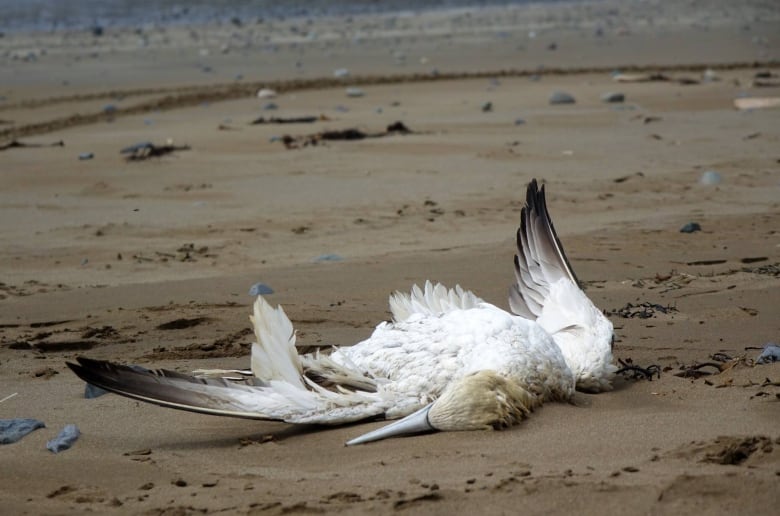
A teenager diagnosed with bird flu in British Columbia is the first domestically acquired human case of H5N1 avian influenza, the Public Health Agency of Canada says.
Since Influenza A or flu viruses are named after the animal where they are most commonly found, avian viruses are naturally found in birds.
H5N1 is a highly transmissible and usually mild disease in geese, swans and seagulls as well as domestic birds such as chickens and turkeys. It has also spread to mammals.
Scientists at the National Microbiology Laboratory in Winnipeg sequenced the genome of the virus from the infected B.C. teen to confirm it is H5N1. The tests showed the version of the virus is related to the avian influenza viruses from the ongoing outbreak in poultry in B.C., the Public Health Agency of Canada said Wednesday.
The version is not the same as the one spreading in dairy cattle in the U.S., PHAC added.
What are the risks to humans?
The H5N1 form of avian influenza remains a virus mainly found in birds.
“Based on current evidence, the risk of avian influenza infection for the general public remains low at this time,” PHAC said. “The risk of avian influenza infection is higher for those who have unprotected exposure to infected animals.”
That’s why officials encourage people who work closely with livestock, such as poultry and dairy farmers, to wear personal protective equipment such as goggles, masks and gloves.

In British Columbia, Provincial Health Officer Dr. Bonnie Henry said in a news conference on Tuesday that humans may be infected by “inhaling the virus in aerosols, in droplets that get into the eyes, back of the throat, nose or deep into the lungs.”
The one known human case in Canada is a teenager in B.C. who is in critical condition, Henry said. About three dozen people who were in contact with the teen have been tested for the virus and none have evidence of infection.
Worldwide, “there’s been very few that might have been transmitted from person to person, so in some ways this is reassuring, in that this virus doesn’t seem to spread easily between people if they get infections. But it also causes very severe illness, particularly in young people,” Henry told reporters.
Henry said it’s very likely that the B.C. teen’s infection took place due to an exposure to either a sick animal or something in the environment, but it is a “real possibility” that researchers may never determine the source.
What are some ways to try to stay safe?
Since the spring of 2022, millions of poultry birds have been culled in Canada to contain an outbreak of highly pathogenic avian influenza (HPAI), including flocks in B.C.’s commercial poultry sector.
“One of the important things that we need to do right now, recognizing that this virus is circulating in wildfowl, so geese and ducks primarily, is to be sure that if you’re in contact with sick birds or dead birds that you don’t touch them directly,” Henry advised.
People are also advised to keep pets away from dead birds since pets, including a dog recently in Ontario, have become infected by biting or eating a dead bird.
“If you have influenza-like symptoms, you should report that immediately to a health-care provider and if you have been in contact with sick animals to basically emphasize that, so that appropriate testing can be done,” Dr. Brian Conway, medical director of the Vancouver Infectious Diseases Centre, suggested.
How was the human case in B.C. identified?
Dr. Theresa Tam, Canada’s chief public health officer, noted the detection was picked up by surveillance at hospitals. People with a respiratory condition are tested for COVID-19, RSV and influenza when they are hospitalized, infectious disease physicians say.
What types of surveillance are there for H5N1?
Henry said wastewater testing looks for H5 influenza in B.C.
But current wastewater testing does not distinguish between human and animal sources. The tests also don’t distinguish between low pathogenic avian influenza and high pathogenic viruses that can cause a lot of illness or death, researchers have reported.
The federal government’s wastewater monitoring dashboard for respiratory activity like influenza includes a map of sites across the country that submit wastewater samples.

PHAC said provincial and territorial public health agencies must report both “confirmed and probable” H5N1 cases within 24 hours.
What is Canada doing to keep out the U.S. version of H5N1?
Bird flu has affected more than 450 dairy farms in 15 states in the U.S. since March. The U.S. Centers for Disease Control and Prevention lists 46 human cases of bird flu since April, with no cases of human-to-human transmission.
The Canadian Food Inspection Agency (CFIA) has also been testing milk for signs of H5N1 in dairy cows. Canada has had no cases of H5N1 reported in dairy cattle.
There’s also no evidence of bird flu in samples of commercial milk. “Milk and milk products that have been pasteurized are safe to consume,” the Public Health Agency of Canada said.
As of April 29, CFIA added to its export certificate requirements for breeding cattle from the U.S., such as certification that lactating cows have tested negative for Influenza A virus.
For poultry, since Feb. 11, 2002, the CFIA has restricted the import of bird by-products from regions with active outbreaks to try to keep out forms of avian influenza that are pathogenic to birds.
The CFIA also requires farmers to report if they suspect their poultry or livestock have avian influenza. The agency says there are currently 28 premises in B.C. with avian flu infections, along with two in Alberta and one in Saskatchewan.

